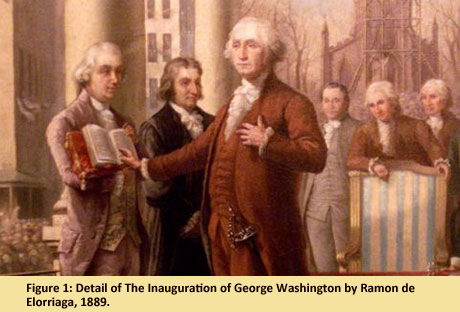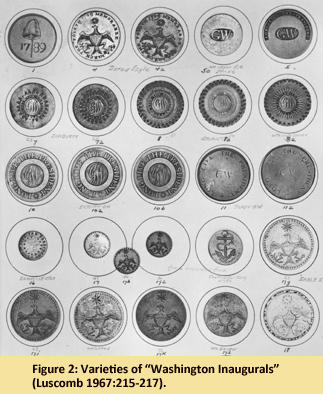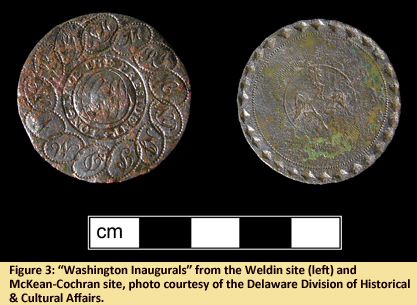"Buttons to Trim the Coat in the Manner I Wish It to Be"
January 2013
By Caitlin Shaffer, MAC Lab Conservator
 As George Washington prepared to become the first president of the United States in April 1789, there was a sweeping sense of excitement and celebration in the air. The only American president in history to be elected by unanimous vote, he experienced a level of approval and admiration that most politicians today can only dream of. Traveling from his home at Mount Vernon to the nation’s capital in New York, he was greeted by cheering onlookers, impromptu parades, and lavish ceremonies all along the way (Chernow 2011). Much as it does today, the inauguration itself consisted of the oath of office, an address, and vast crowds looking to commemorate a moment in history.
As George Washington prepared to become the first president of the United States in April 1789, there was a sweeping sense of excitement and celebration in the air. The only American president in history to be elected by unanimous vote, he experienced a level of approval and admiration that most politicians today can only dream of. Traveling from his home at Mount Vernon to the nation’s capital in New York, he was greeted by cheering onlookers, impromptu parades, and lavish ceremonies all along the way (Chernow 2011). Much as it does today, the inauguration itself consisted of the oath of office, an address, and vast crowds looking to commemorate a moment in history.
At his inauguration (Figure 1), Washington was noted as wearing an American-made wool coat of “deep brown, with metal buttons, with eagles on them…” (MacNeil 1977:14) These gilt buttons were made especially for Washington at his request to mark the occasion; in a 1789 letter, he ordered “six more of the large (engraved) buttons to trim the coat in the manner I wish it to be” (MacNeil 1977:14). Likewise, manufacturers had foreseen the market for such items and were producing “Washington Inaugurals,” button sets sold to the general public. Worn on coats, waistcoats, or breeches as a sign of respect for the president and the historic occasion, some of the more popular designs featured the president’s initials, an eagle holding arrows and an olive branch, the phrases “Long Live the President” and “E Pluribus Unum,” or linked ovals with the initials of the original thirteen states. Some fifty varieties of “Washington Inaugurals” (Figure 2) have been identified to date (Cunningham 1994:14). Believed to have been produced in New England by hardware or coin makers, the buttons were available in copper, brass, and silver plate (Luscomb 1967:214).

 Recent archaeological investigations of two sites in Delaware, Weldin Farm and McKean-Cochran Farm, have unearthed two “Washington Inaugurals” (Figure 3). The button from the Weldin site features the “linked states” design, and it was found in a kitchen structure with a high concentration of sewing-related artifacts (Shaffer et al. 2012:468). While records show that the property was owned by John Dickinson and his descendants from 1785-1862, the farm was leased by tenants, and so it is unknown who may have worn this button (Shaffer et al. 2012:455). The McKean-Cochran button is an unusual variation with a small eagle in the center surrounded by a sunburst and diamond-pattern border. The identity of the occupants at this site in the late 18th century is also unclear. Although owned by Letitia McKean, tax records from 1797 show that the land was being leased to tenant farmers (Bedell et al. 1999:115). However, we do know that the button was recovered from a cellar along with other military paraphernalia. This suggests that at least one of the tenants may have had a connection to the Continental Army (Bedell et al. 1999:89, 91), perhaps a member of a militia who expressed his national pride by wearing a set of “Washington Inaugurals.”
Recent archaeological investigations of two sites in Delaware, Weldin Farm and McKean-Cochran Farm, have unearthed two “Washington Inaugurals” (Figure 3). The button from the Weldin site features the “linked states” design, and it was found in a kitchen structure with a high concentration of sewing-related artifacts (Shaffer et al. 2012:468). While records show that the property was owned by John Dickinson and his descendants from 1785-1862, the farm was leased by tenants, and so it is unknown who may have worn this button (Shaffer et al. 2012:455). The McKean-Cochran button is an unusual variation with a small eagle in the center surrounded by a sunburst and diamond-pattern border. The identity of the occupants at this site in the late 18th century is also unclear. Although owned by Letitia McKean, tax records from 1797 show that the land was being leased to tenant farmers (Bedell et al. 1999:115). However, we do know that the button was recovered from a cellar along with other military paraphernalia. This suggests that at least one of the tenants may have had a connection to the Continental Army (Bedell et al. 1999:89, 91), perhaps a member of a militia who expressed his national pride by wearing a set of “Washington Inaugurals.”
“Washington Inaugurals” were the very first American presidential mementos, treasured both then and now for their place in history and for the patriotic pride that they signified. While political memorabilia today tends to be throwaway, farcical, and certainly less permanently attached to our clothing, these buttons started it all!
| References |
|
| Bedell, John and Ingrid Wuebber, Meta Janowitz, Marie-Lorraine Pipes, Sharla Azizi, and Charles H. LeeDecker |
| 1999 |
Farm Life on the Appoquinimink, 1750-1830 Archaeological Discoveries at the McKean/Cochran Farm Site Odessa, New Castle County, Delaware. Report prepared for the Delaware Department of Transportation. Website accessed 17 December 2012. |
|
| Chernow, Ron |
| 2011 |
George Washington: The Reluctant President. Smithsonian Magazine. www.smithsonianmag.com/history-archaeology/George-Washington-The-Reluctant-President.html Website accessed 17 December 2012. |
|
| Cunningham Jr., Noble E. |
| 1994 |
Political Dimensions of Everyday Life in the Early Republic. In Everyday Life in the Early Republic. Catherine E. Hutchins, ed. Pp. 3-33. The Henry Francis du Pont Winterthur Museum, Inc., Winterthur, DE. |
|
| Luscomb, Sally C. |
| 1967 |
The Collector’s Encyclopedia of Buttons. Crown Publishers, Inc., New York, NY. |
|
| MacNeil, Neil |
| 1977 |
The President’s Medals 1789 – 1977. Clarkson N. Potter, Inc., New York, NY. |
|
| Shaffer, Barbara and Brenda Weller, Robert Eiswert, Richard White, Jerry Clouse, Francine Arnold, Kevin Simons, Charles Richmond, and Keith Doms |
| 2012 |
Archaeological Data Recovery Investigations 7NC-B-11, The Weldin Plantation Site Blue Ball Properties Area Transportation Improvement Project Brandywine Hundred, New Castle County, Delaware. Report prepared for the Delaware Department of Transportation. www.deldot.gov/archaeology/weldin/phaseIII/ Website accessed 17 December 2012. |
|